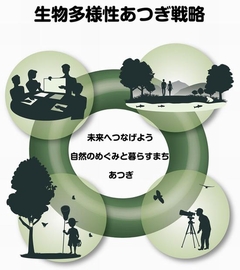September 1, 2013
Atsugi Develops Biodiversity Strategy
Keywords: Ecosystems / Biodiversity Local government Policy / Systems

The city of Atsugi in Kanagawa Prefecture, located about 45 kilometers from Tokyo, established the Atsugi Biodiversity Strategy in March 2013 to enhance the natural environment and pass this blessing on to future generations, according to an announcement made on April 19, 2013.
The strategy is based on the Basic Act on Biodiversity, which came into effect in June 2008. Atsugi became the second municipality in Kanagawa Prefecture to draw up a basic plan on biodiversity after Yokohama, which formulated its own biodiversity action plan known as the Yokohama b Plan ("b" for biodiversity) in April 2011.
In Atsugi, some 4,700 animal species and about 1,600 plant species have been identified and recorded, but the diversity of resident flora and fauna is being lost in areas such as mountains, rivers and rural, highly biodiverse regions near human settlements (known in Japan as satochi-satoyama) due to development, urbanization, adverse effects of non-native species on ecosystems, and other factors. A questionnaire survey of Atsugi residents conducted in November 2011 during the formulation of the strategy revealed issues such as a lack of familiarity with the meaning of "biodiversity," despite the wide-spread recognition of the word itself, and a lack of knowledge about how to participate in activities to preserve biodiversity.
Against this backdrop, Atsugi plans to promote three objectives and eight action-plan items as part of the strategy. The three objectives are: 1) preserving and restoring diverse natural environments, 2) collecting and storing information on biodiversity in a database, and 3) enhancing public awareness and disseminating knowledge concerning the meaning and significance of biodiversity, as well as cultivating human resources to proactively address these issues.
Related
"JFS Newsletter"
- 'What Are the Roles of Zoos Today?' - Interview with Director of the Popular Asahiyama Zoo
- Nishiawakura's Initiative for 100% Energy Self-Sufficiency, and a Municipal ICO Scheme
- 15-Year Integrated Forest Environment Education in Shimokawa, Hokkaido to Support Sustainable Forest Management
- Fifth Contest to Award Excellent Environmental and Social Practices by Junior High, High School Students
- Increase Revenues without Increasing Catches -- How the Sustainable Sakura Shrimp Fishery in Suruga Bay Does It


